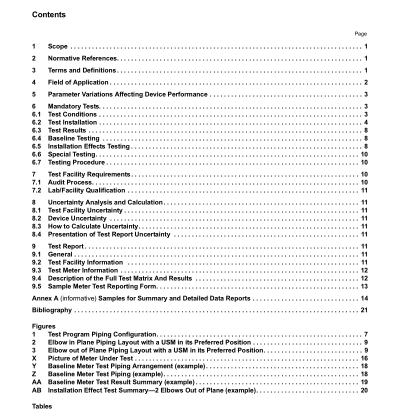API MPMS 22.3:2015 pdf free download.Manual of Petroleum Measurement Standards Chapter 22.3 Testing Protocol for Flare Gas Metering
5 Parameter Variations Affecting Device Performance As discussed in API MPMS Chapter 14.10 there are many parameters that may affect the performance of the device. The key parameters that will best define the performance of the Flare Flow Meter System (FFMS) metering component include but are not limited to the following:
— pressure;
— temperature;
— gas composition;
— environmental conditions;
— installation conditions such as upstream piping disturbances (influences will vary between different meter
technologies);
— velocity;
— Reynolds Number;
— phase changes.
6 Mandatory Tests
6.1 Test Conditions
Written procedures should be developed by the testing facility and agreed by the party requesting the test prior to the start of any testing. The sequence of tests should be considered and any tests that can alter device performance should be completed last.
All deviations from written procedures or standards shall be documented. During the test, the environment should stay as stable as possible minimizing temperature, pressure, and barometric pressure excursions.For this reason the entire test should be conducted in one setting. Care should be taken to ensure that environmental/external conditions not being tested are held as consistent as possible to minimize their effect on the test results.
The environmental/external conditions shall be recorded and reported. The average operating value and range of temperature, relative humidity, and atmospheric pressure during the test shall be measured and reported. Significant temperature changes may influence the performance of flare flow meters through the change of critical geometric parameters and fluid properties. Meter manufacturers shall state corrections to be used in data processing.
It is generally impractical to change the fluid temperature in a flow laboratory; consequently, the flowing fluid temperature should simply be recorded. It is the responsibility of the manufacturer to specify the allowable range of the flare meter to be used with specific fluids, based on the thermodynamic properties of the fluids, mechanical and fluid dynamic constraints. In no case shall the velocities in these tests exceed the limits imposed by mechanical and fluid dynamic constraints. If the flare meter is sensitive to compositional changes, then the manufacturer shall provide documentation detailing the sensitivity of their meter to changes in composition. In some cases additional testing may also be required to validate the sensitivity to fluid composition.
Air and other gases can be used provided the test fluid remains homogeneous and in a single phase during the test. The end-user’s composition may vary so it is the end-user’s responsibility to obtain correlating data from the manufacturer detailing how the meter will respond to the end user’s application.
6.2 Test Installation
6.2.1 General
This section defines:
— the type of tests needed;
— the type of instruments to be tested;
— the range of environmental conditions;
— the range of process conditions;
— the fluid for testing the flare flow meter;
— the size of the process piping;
— process piping connections;
— upstream and downstream piping;
— the variables to be recorded;
— traceability and calibration records of laboratory measurement equipment.
6.2.2 Type of Tests
6.2.2.1 Baseline Testing
In order to identify the influence of certain parameters or changes to the operating conditions, baseline tests are necessary. The following testing is required to determine the flare flow measurement instrument’s performance:
— reference accuracy,
— linearity,
— repeatability,
— hysteresis,
— rangeability.
For meters that are sensitive to other influence parameters such as pressure, temperature, or compositional changes,
baseline testing shall also address these parameters.
6.2.2.2 Non-ideal Condition Testing
Non-ideal condition testing quantifies environmental effects and the dynamic performance of flare flow measurement
instruments including:
— non-ideal piping configuration [one elbow in plane (EIP), two close-coupled elbows out of plane (EOP)].
Manufacturers shall also demonstrate the sensitivity of their meter to pressure, temperature and compositional changes and if necessary provide additional documentation and/or testing.API MPMS 22.3 pdf download.API MPMS 22.3:2015 pdf free download
